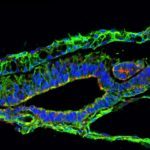Link to Pubmed [PMID] – 24626928
Science 2014 Mar;343(6176):1253-6
Vertebrate limbs first emerge as small buds at specific locations along the trunk. Although a fair amount is known about the molecular regulation of limb initiation and outgrowth, the cellular events underlying these processes have remained less clear. We show that the mesenchymal limb progenitors arise through localized epithelial-to-mesenchymal transition (EMT) of the coelomic epithelium specifically within the presumptive limb fields. This EMT is regulated at least in part by Tbx5 and Fgf10, two genes known to control limb initiation. This work shows that limb buds initiate earlier than previously thought, as a result of localized EMT rather than differential proliferation rates.

